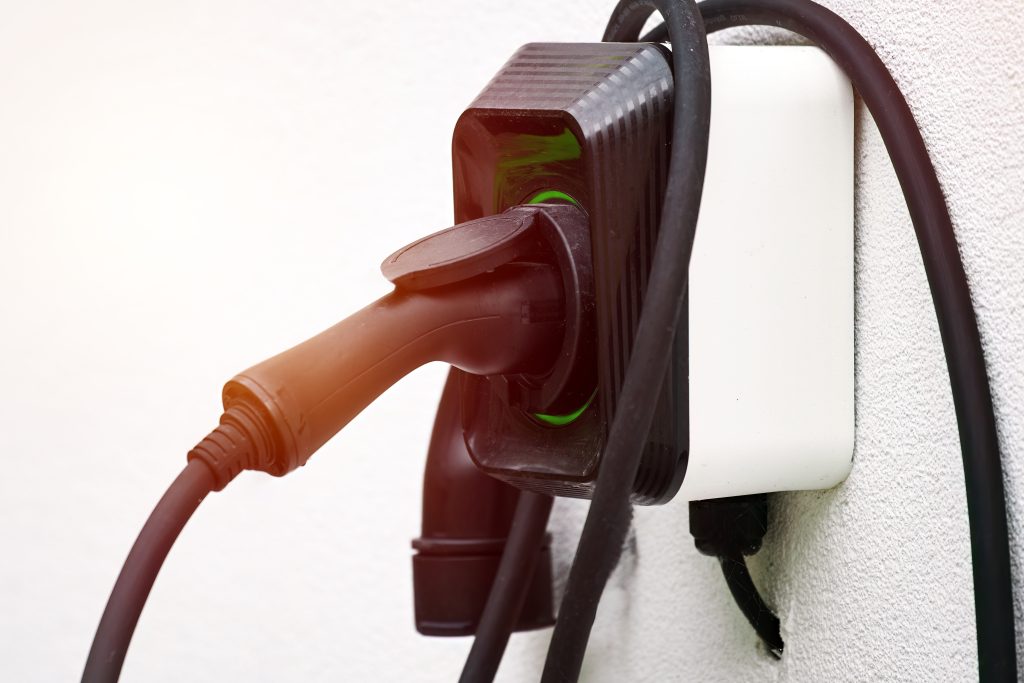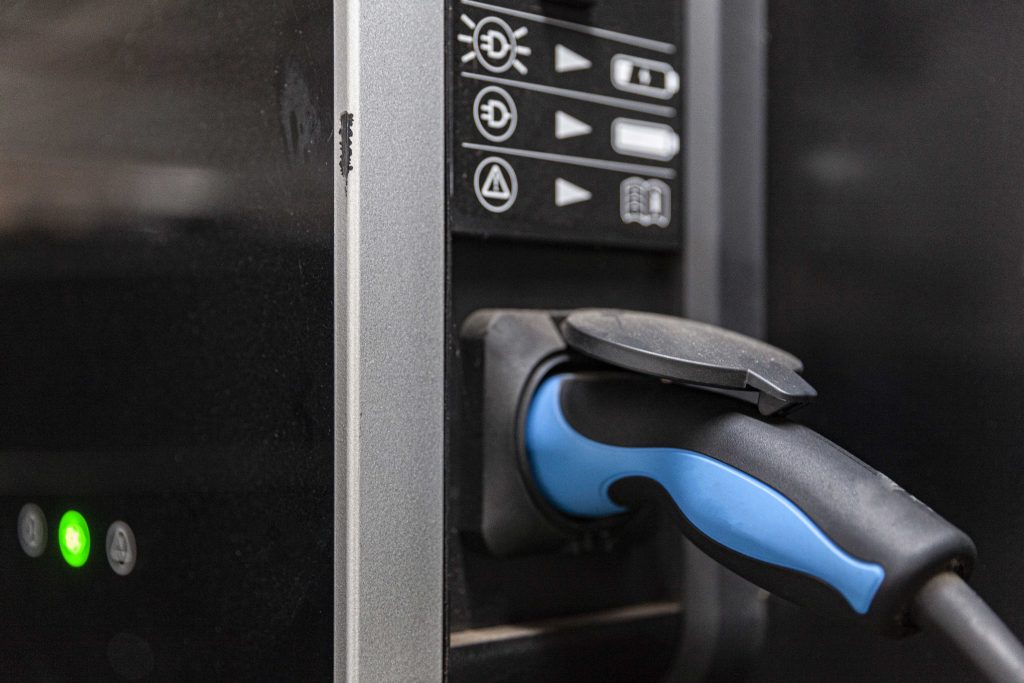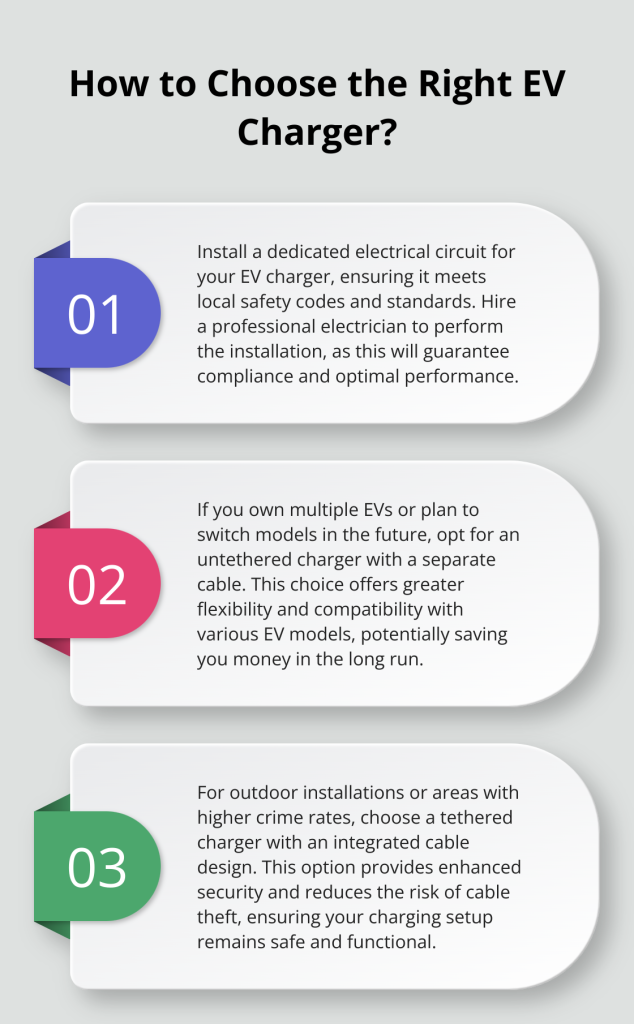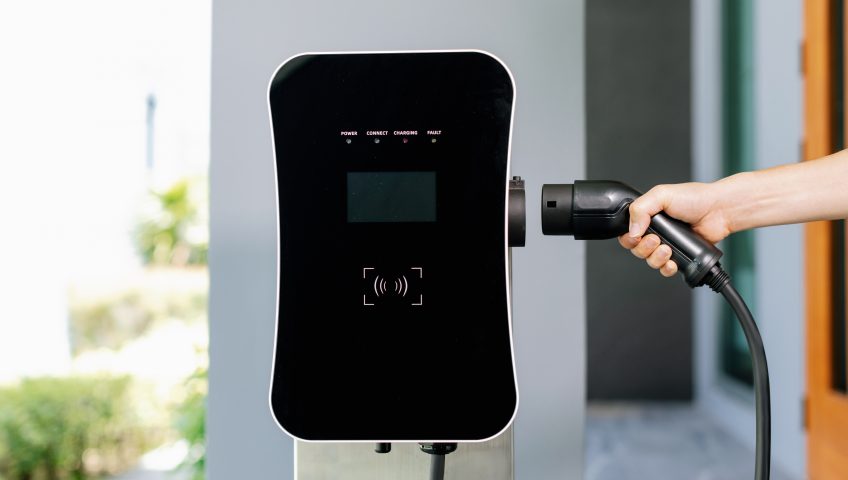Electric vehicle (EV) charging technology has come a long way, offering various options for EV owners. At ROS Electric, we often get asked about the differences between tethered and untethered EV chargers. Understanding these distinctions is crucial for making an informed decision when installing a charging station. Let’s explore what sets tethered and untethered EV chargers apart, helping you choose the best option for your needs.

What Are Tethered EV Chargers?
Tethered EV chargers represent a popular choice for electric vehicle owners. These charging units come with a permanently attached cable and eliminate the need to bring or store a separate cable. Tethered chargers typically feature a J1772 connector in North America. The cable length usually ranges from 5 to 8 meters, providing flexibility for various parking situations. Most tethered units offer Level 2 charging capabilities, which can fully charge an EV in 4 to 8 hours (according to the U.S. Department of Energy).
Advantages of Tethered Chargers
Convenience stands out as one of the main benefits of tethered chargers. Users simply park their car, grab the cable, and plug it in – no need to retrieve a separate cable from the trunk or garage. This simplicity proves particularly valuable during inclement weather or late-night charging sessions.
Tethered chargers also offer enhanced security. The integrated cable design makes theft much less likely compared to untethered options. This feature holds special value for outdoor installations or in areas with higher crime rates.
Potential Drawbacks
While tethered chargers offer numerous benefits, they do have some limitations:
- Limited Flexibility: The fixed cable type means less adaptability if you switch to an EV with a different connector type in the future.
- Higher Initial Cost: Tethered units tend to be slightly more expensive than their untethered counterparts due to the included cable.
- Maintenance Concerns: If the cable becomes damaged, you may need to replace the entire unit rather than just the cable. This can lead to higher long-term costs compared to untethered options.
- Aesthetic Considerations: Some users find tethered chargers less appealing due to the visible cable. This might present a drawback if you prefer a clean and minimalistic look for your charging setup.
Installation and Compatibility
Tethered charger installation often requires professionals, like ROS Electric, to ensure proper wiring and safety compliance. The installation process typically involves mounting the unit on a wall or pedestal and connecting it to your home’s electrical system. Most tethered chargers work with a wide range of electric vehicles, but it’s essential to verify compatibility with your specific model before purchase.

What Are Untethered EV Chargers
Untethered EV chargers (also known as socketed or universal chargers) provide a distinct approach to electric vehicle charging. These units do not include a permanently attached cable. Instead, they feature a socket where users can connect their own charging cables. This design offers flexibility and adaptability, making untethered chargers a popular choice for many EV owners.
Benefits of Using Untethered Chargers
Versatility in Charging
Untethered chargers excel in their compatibility with various EV models. As long as you possess the appropriate cable, you can charge almost any electric vehicle. This versatility proves particularly beneficial for households with multiple EVs or for those who frequently host guests with different EV makes.
Cost-Effective Long-Term Solution
While the initial cost of an untethered charger might be lower than a tethered unit, the real savings materialize in the long run. If your charging cable sustains damage or you switch to an EV with a different connector type, you only need to replace the cable (not the entire charging unit). This can result in significant cost savings over time, especially as EV technology continues to evolve.
Space-Saving Design
Untethered chargers often boast a sleeker, more compact design compared to their tethered counterparts. Without a permanently attached cable, these units can blend more seamlessly into your home’s aesthetic. For those who prioritize a clean, minimalist look, untethered chargers offer an attractive solution.
Limitations to Consider
While untethered chargers offer numerous advantages, they do come with some limitations:
- Users need to remember to bring and store their charging cables, which can prove inconvenient.
- The lack of an integrated cable means these units might be more susceptible to theft or damage in public settings.
- Additional storage space might be required for the separate charging cable (which can be up to 25 feet long).
The choice between tethered and untethered chargers ultimately depends on individual needs and preferences.
How to Choose the Right EV Charger

Your choice depends on specific needs, circumstances, and your plans for EV ownership. Consider factors such as the number of EVs you own, potential model changes, budget constraints, and installation location when making your decision. The EV charging landscape continues to evolve rapidly, with trends towards faster charging speeds and increased smart features for both types of chargers.
Contact ROS Electric for EV Charger Installation Today
At ROS Electric, we understand the importance of selecting the right EV charger for your needs. Our team of experienced professionals is ready to guide you through the selection and installation process. Contact ROS Electric today to learn more about our top-notch EV charger installation, and electrical services to support your EV charging solutions!


Write a Comment